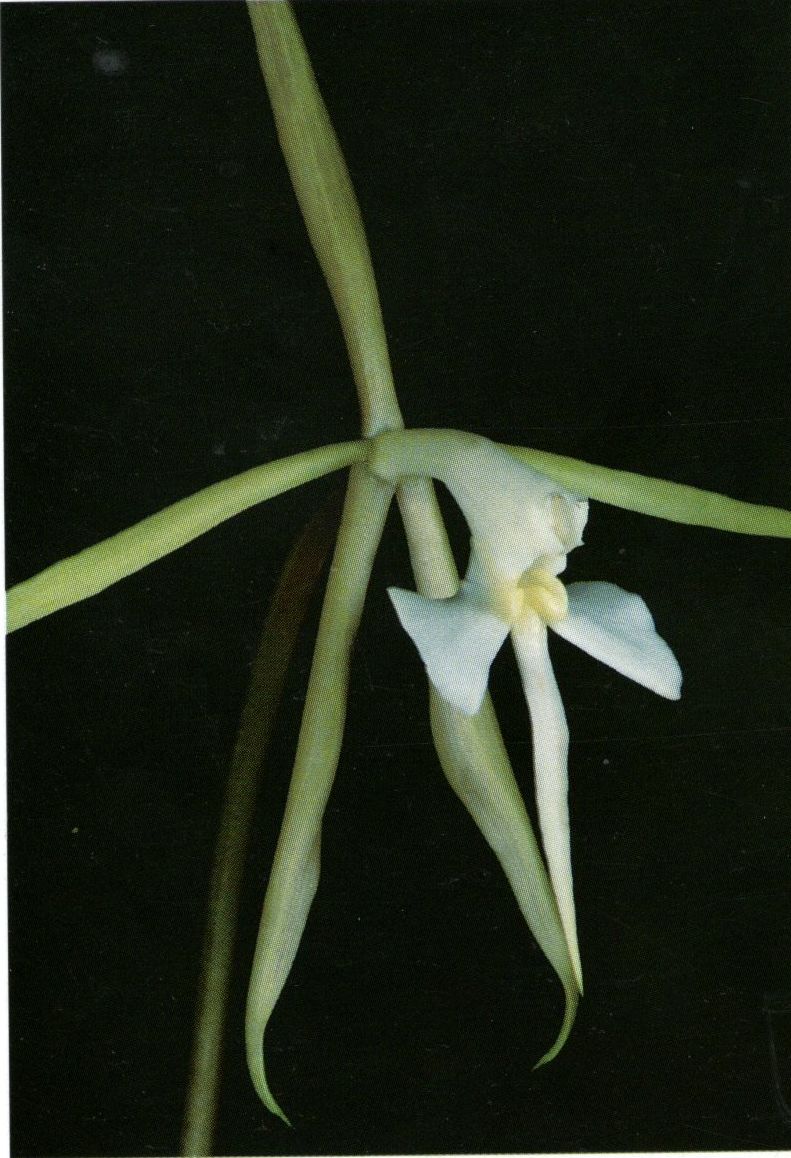

Epidendrum spruceanum Lindl. 1853 GROUP Nocturnum SUBGROUP Nocturnum
Photos by © Roberto Vasquez
Drawing by © Jimenez, Hágsater & E.Santiago and The AMO Herbario Website
Drawing by © Dodson & Vasquez and The Swiss Orchid Foundation at the Jany Renz Herbaria Website

 LATE
LATE 

Common Name Spruce's Epidendrum [English Botanist and Amazonian orchid collector later 1800's]
Flower Size 2" [5 cm]
Found in Peru, Bolivia and Brazil in wet tropical forests at elevations around 300 meters as a large to giant sized, hot growing, suberect epiphyte with slender, cane-like, slightly flexuous, laterally flattened stems enveloped by numerous, tubular, becoming foliaceous sheaths above and carrying 5 to 6, all along the apical 2/3's of the stem, distichous, coriaceous, green, narrowly elliptic, evidently marked veins and keels, apically bilobed, mucronate leaves that blooms in the late spring and summer on a terminal, without a spathe, erect, peduncle short, .2 to .6" [.5 to 1.5 cm] long, 2.2 to 8" [5.5 to 20 cm] long overall, pluri-racemose, occuring over several years form the same raceme, successively single, several flowered inflorescence with much shorter than the ovary, triangular, acute, embracing floral bracts and carrying resupinate flowers with the tepals green to yellowish and the lip and column are white.
"Epidendrum spruceanum is part of GROUP Nocturnum SUBGROUP Nocturnum haracterized by the simple stems carrying large star-shaped flowers usually with a 3-lobed lip. The species is recognized by the laterally compressed stems, 5 to 6 leaves, their length/width ratio 2 to 4:1, generally 4 to 7" [x .8 to 1.8" [10 to 17.5 x 2.0 to 4.5 cm], ovary short, 1,48 to 1.8" [37 to 45 mm] long, shorter than the sepals and petals which are 1.92 to 2.8" [48-70 mm] long, racemes evident at the base of the leaf, rachis fractiflex, column .48 to .8" [12-20 mm] long; body of capsule centered. Epidendrum nocturnum Jacq. is widely distributed from Florida to Bolivia, has terete stems, shorter leaves, 1.48 to 5.6" [3.7 to 14 cm] long, longer ovary, 2 to 2.8" [50 to 70 mm] long, about as long as the sepals which are 1.4 to 3" [35 to 75 mm] long, peduncle and rachis shorter, column .6 to .8" [15 to 20 mm] long, body of capsule occupying nearly the full length, centered. Epidendrum tumuchumaciense (Veyret) Carnevali & G.Romero along the Amazon slope of the Guyana Shield, from Colombia to the French Guyana, has 6 to 27 leaves, shorter, narrower, ratio 2 to 3:1, 1.2 to 3.68" x .48 to 1.12" [3 to 9.2 x 1.2 to 2.8 cm], distributed throughout the stems, erect, green to reddish, occasionally deep wine-red, ovary generally 3.2 to 4" [80 to 100 mm] long, longer than the sepals 1.92 to3.24" [48 to 81 mm], peduncle and rachis to .8" [2 cm] long; body of the capsule occupying the apical half of the capsule. Epidendrum tridens Poepp. & Endl. is distributed along the base of the Andes in Ecuador, Peru and Bolivia as well as south of the Guyana Shield in Venezuela, and has 3 to 5 progressively longer leaves, 3 to 5:1, 3.4 to 6 x .8 to 2" [8.5 to 15 x 2 to 5 cm], dark green, the underside occasionally tinged purple, and has a longer ovary 2.4 to 4" [60 to 100 mm], longer than the sepals 1.6 to 2.56" [40 to 63 mm], peduncle and rachis very short; column straight, .84 to .92" [21 to 23 mm] long; the body of the fruit is at the center of the ovary. Epidendrum carpophorum Barb.Rodr. is similar to E. tridens, and is found along the Caribbean coast of Venezuela, Guyana and southeastern Brazil, has dark green leaves occasionally the underside tinged purple, a slightly arching column and the body of the fruit is located slightly displaced towards the upper half of the ovary." Hagsaer etal 2015
Synonyms
References W3 Tropicos, Kew Monocot list , IPNI ; Orchidaceae Brasilense Band 1 Pabst & Dungs 1975 drawing good; Icones Plantarum Tropicarum Plate 336 Dodson & Vasquez 1989 drawing fide; Orchids of Bolivia Vol II Laelinae Vasquez & Ibisch 2004 drawing/photo fide; Icones Orchidacearum 15[1] plate 1561 Hagsater and Sanchez 2015 drawing fide; Icones Orchidacearum 15 [2] Plate 1594 Hagsater & Sanchez 2016 see recognition section; Orquideas, Tesoro de Colombia Vol 2 Ortiz & Uribe 2017; Icones Orchidacearum 18(1) plate 1803 2020 see recognition section; Icones Orchidacearum 18(1) plate 1822 2020 ; Icones Orchidacearum 18(1) plate 1840 Hagsater, Santiago and Medina 2020 see recognition section
--------------------------------------------------------------------------------------------------------------------------